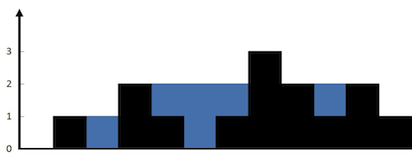LeetCode-in-All
42. Trapping Rain Water
Hard
Given n non-negative integers representing an elevation map where the width of each bar is 1, compute how much water it can trap after raining.
Example 1:

Input: height = [0,1,0,2,1,0,1,3,2,1,2,1]
Output: 6
Explanation: The above elevation map (black section) is represented by array [0,1,0,2,1,0,1,3,2,1,2,1]. In this case, 6 units of rain water (blue section) are being trapped.
Example 2:
Input: height = [4,2,0,3,2,5]
Output: 9
Constraints:
n == height.length1 <= n <= 2 * 1040 <= height[i] <= 105
Solution
#include <stdio.h>
int trap(int* height, int heightSize) {
int l = 0;
int r = heightSize - 1;
int res = 0;
int lowerWall = 0;
while (l < r) {
int lVal = height[l];
int rVal = height[r];
// Determine which side has the lower wall and add water accordingly
if (lVal < rVal) {
// Update lower wall height if lVal has increased
lowerWall = lVal > lowerWall ? lVal : lowerWall;
// Add the trapped water at this position
res += lowerWall - lVal;
// Move left pointer
l++;
} else {
// Update lower wall height if rVal has increased
lowerWall = rVal > lowerWall ? rVal : lowerWall;
// Add the trapped water at this position
res += lowerWall - rVal;
// Move right pointer
r--;
}
}
return res;
}

